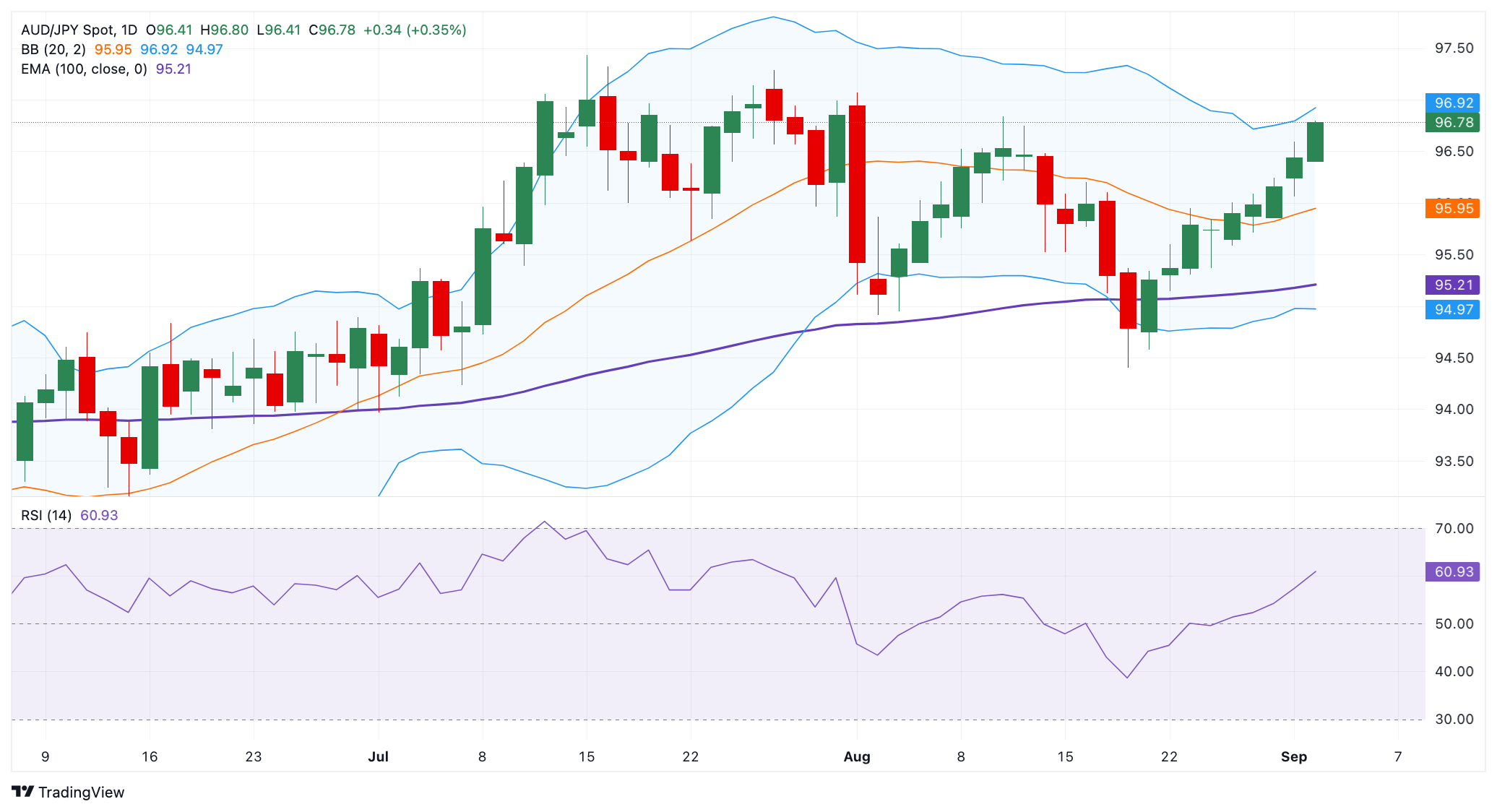AUD/JPY Price Forecast: Retains bullish bias, first upside target emerges near 97.00
- AUD/JPY gathers strength to near 96.80 in Tuesday’s early European session, adding 0.34% on the day.
- The positive outlook of the cross prevails above the 100-day EMA, with bullish momentum in the near term.
- The first upside target is seen in the 96.95-97.00 region; the initial support level is located at 95.86.
The AUD/JPY cross attracts some buyers around 96.80 during the early European session on Tuesday. The Japanese Yen (JPY) softens against the Australian Dollar (AUD) amid the uncertainty over the likely timing of the next interest rate hike by the Bank of Japan (BoJ). The release of Australia’s Gross Domestic Product (GDP) for the second quarter (Q2) will be in the spotlight later on Wednesday.
Technically, the constructive outlook of the cross remains in play, with the price holding above the key 100-day Exponential Moving Average (EMA) on the daily chart. The path of least resistance is to the upside, as the 14-day Relative Strength Index (RSI) stands above the midline near 60.95. This indicates bullish momentum in the near term.
The immediate resistance level for AUD/JPY emerges in the 96.95-97.00 zone, representing the upper boundary of the Bollinger Band and a round figure. A run of green candles and steady trading above the mentioned level could open the door for a move toward 97.29, the high of July 28. The additional upside filter to watch is 97.43, the high of July 15.
On the flip side, if the cross draws in sellers and more red candlesticks show up, the price could head right back to 95.86, the low of August 29. Sustained trading below this level could expose 95.21, the 100-day EMA. The next contention level is located at 95.00, representing the lower limit of the Bollinger Band and the psychological level.
AUD/JPY Daily Chart

Australian Dollar FAQs
One of the most significant factors for the Australian Dollar (AUD) is the level of interest rates set by the Reserve Bank of Australia (RBA). Because Australia is a resource-rich country another key driver is the price of its biggest export, Iron Ore. The health of the Chinese economy, its largest trading partner, is a factor, as well as inflation in Australia, its growth rate and Trade Balance. Market sentiment – whether investors are taking on more risky assets (risk-on) or seeking safe-havens (risk-off) – is also a factor, with risk-on positive for AUD.
The Reserve Bank of Australia (RBA) influences the Australian Dollar (AUD) by setting the level of interest rates that Australian banks can lend to each other. This influences the level of interest rates in the economy as a whole. The main goal of the RBA is to maintain a stable inflation rate of 2-3% by adjusting interest rates up or down. Relatively high interest rates compared to other major central banks support the AUD, and the opposite for relatively low. The RBA can also use quantitative easing and tightening to influence credit conditions, with the former AUD-negative and the latter AUD-positive.
China is Australia’s largest trading partner so the health of the Chinese economy is a major influence on the value of the Australian Dollar (AUD). When the Chinese economy is doing well it purchases more raw materials, goods and services from Australia, lifting demand for the AUD, and pushing up its value. The opposite is the case when the Chinese economy is not growing as fast as expected. Positive or negative surprises in Chinese growth data, therefore, often have a direct impact on the Australian Dollar and its pairs.
Iron Ore is Australia’s largest export, accounting for $118 billion a year according to data from 2021, with China as its primary destination. The price of Iron Ore, therefore, can be a driver of the Australian Dollar. Generally, if the price of Iron Ore rises, AUD also goes up, as aggregate demand for the currency increases. The opposite is the case if the price of Iron Ore falls. Higher Iron Ore prices also tend to result in a greater likelihood of a positive Trade Balance for Australia, which is also positive of the AUD.
The Trade Balance, which is the difference between what a country earns from its exports versus what it pays for its imports, is another factor that can influence the value of the Australian Dollar. If Australia produces highly sought after exports, then its currency will gain in value purely from the surplus demand created from foreign buyers seeking to purchase its exports versus what it spends to purchase imports. Therefore, a positive net Trade Balance strengthens the AUD, with the opposite effect if the Trade Balance is negative.

